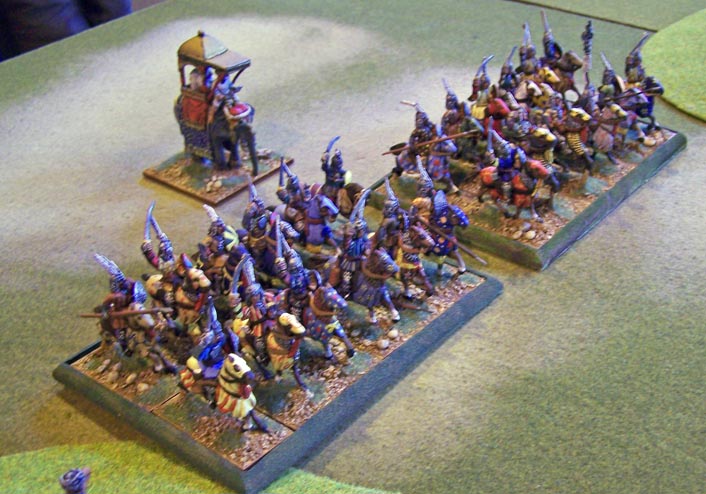|
Targe 2008
Early Mughal India The Mughal Empire was established in the early 1500s by the Timurid prince Babur, a descendant of Genghis Khan and Timur. After carving out a state in Afghanistan he conquered most of Northern India. Although the Timurid elite, like Babur, were of Mongol origin they were strongly influenced by the military traditions of Iran. In 1526, Babur defeated the last of the Delhi Sultans, Ibrahim Shah Lodi, at the First Battle of Panipat. To secure his kingdom, Babur then had to face the Rajput confederacy until their defeat at the Battle of Khanwa. Babur’s early army consisted of Turkish, Mongol, Iranian and Afghan troops organised in the traditional Turkish and Mongol manner. The military successes of the Mughals was achieved by an army much smaller than its opponents but with superior discipline and cohesion. It combined elite cavalry with horse armour, horse archers, matchlock musket infantry and artillery. Babur's son Humayun succeeded him in 1530 but suffered major reversals mainly at the hands of the Shir Khan and effectively lost most of the empire before it could develop as a major state. From 1540 Humayun was a ruler in exile, reaching the Persian Court in 1542 while his forces still controlled some fortresses and small regions. When the Afghans fell into disarray with the death of Shir Khan, Humayun returned and managed to reconquer Delhi in 1555. Humayun then conquered the central plateau around Delhi, but months later died in an accident. Akbar succeeded his father on 14 February 1556 and was probably the greatest Mughal Emperor, tolerating all religions and reorganising the army. For over 40 years he was engaged in warfare either against internal rebels or on the borders of the expanding empire that grew to a population of over a hundred million people. The Game Akbar’s early campaigns were in the north defeating Afghan and Uzbeg rebels and then Rajputs of Mewar based in their capital Chitor. Akbar incorporated the fierce Rajputs into the empire leaving them largely autonomous and they became an important part of his army. He then turned his attentions east to Bengal. A short campaign in this land of rivers and jungle resulted in Moghul annexation of the main cities but rebels controlled the countryside. His tolerant religious policies resulted in muslim rebellions, the most serious in Bengal that took four years to subdue. The later campaigns of his reign were in the west starting in the Punjab and then expanding into Kashmir, Baluchistan and Sind. Finally he moved south into the Deccan annexing the Khandesh. It was during Akbar’s reign that the first European contacts were made. Firstly with the Portuguese in Goa and then the English through the East India Company. Today’s game is loosely based on one of the Hindu rebellions. The Mughal army is faced by a typical Hindu army of the mid 16thC. The Mughal’s after Akbar Akbar’s son Jahangir ruled the empire from 1605–1627 and attempted to simplfy the increasingly complex army structure without success. Rebellious provinces became a law unto themselves and the army gained a reputation as being fierce but indisciplined. In 1627, his son Shah Jahan succeeded to the throne. At this stage Mughal India was perhaps the greatest empire in the world. He commissioned the famous Taj Mahal in 1630 in Agra as a tomb for his wife Mumtaz Mahal. By 1700 the empire, under the leadership of Aurangzeb, reached its peak with major parts of present day India, except for the North eastern states, the Sikh lands in Punjab, the lands of the Marathas, areas in the south and most of Afganistan under its domain. Aurangzeb was the last of what are known as the Great Mughal Emperors. The Tabletop Mughal Army There are two main 28mm ranges that have been used for this army. Bearsden Miniatures do a full Mughal range with every main troop type. I supplemented these with the Foundry India range that covers the whole Mughal period right up to the Indian Mutiny. They match together fairly well and for variety insert a few Ottoman and Persian heavy cavalry from other ranges. Central Asian light cavalry fought in India and these typical horse archers are readily available. With a small conversion the Foundry Africa range provides a few infantry options. The rules used in this demo are Warhammer Ancient Battles (WAB). Whilst this is a little out of their time period they are a better fit than the later WECW. There are several special rules in the army lists but most will be found in the WAB supplement Vlad the Impaler. Whilst there are limited historical opponents for a Mughal army outside India (Persian’s mainly), the army does have the advantage of a long shelf life. Most of the figures can be used for the 18th campaigns involving the French and British (led by Clive of India) through Wellington’s campaigns and up to the Indian Mutiny. Recommended reading An excellent narrative history of the period is ‘The Mughal Throne’ by Abraham Eraly. For more on the army the must read title is ‘Mughal Warfare’ by Jos Gommans in the Routledge ‘Warfare and History’ series. For the fine detail The Army of the Indian Moghuls by Wiliam Irvine (Delhi 1994) and last but not least Osprey MAA 263 Mughul India 1504-1761 by David Nicolle. Sadly out of print and not easy to find. Osprey Fortress 51 Indian Castles is just before our period but is a great introduction to castles and siege warfare in India. A more detailed article and army lists for WAB is scheduled to appear in a forthcoming edition of Wargames Illustrated. |
Proudly powered by Weebly







